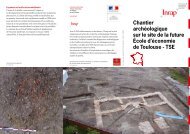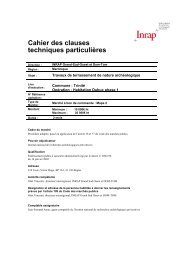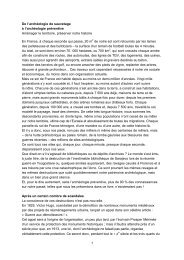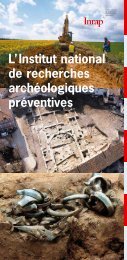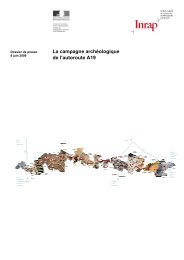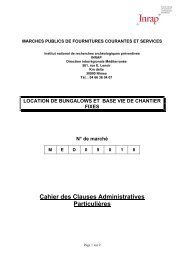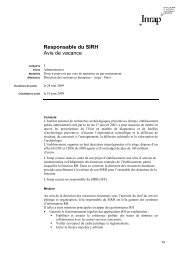Vestiges de la traite négrière - Inrap
Vestiges de la traite négrière - Inrap
Vestiges de la traite négrière - Inrap
You also want an ePaper? Increase the reach of your titles
YUMPU automatically turns print PDFs into web optimized ePapers that Google loves.
L’HaBiTaT eT La cULTUre MaTÉrieLLe – 10 Mai 2012<br />
Dernières fouilles dans <strong>de</strong>ux villes portugaises du Cap-Vert,<br />
<strong>la</strong> Cida<strong>de</strong> Velha et Alcatraz<br />
christopher evans, University of cambridge<br />
Des fouilles <strong>de</strong> sauvetage ont été<br />
conduites à <strong>la</strong> Cida<strong>de</strong> Velha et<br />
à Alcatraz, au Cap-Vert. Les îles<br />
du Cap-Vert étaient inhabitées à leur<br />
découverte en 1456, mais dix ans plus<br />
tard, on y importait <strong>de</strong>s hommes et <strong>de</strong>s<br />
ressources pour y établir <strong>de</strong>s p<strong>la</strong>ntations<br />
et faire du commerce avec l’Afrique <strong>de</strong><br />
l’Ouest. L’île principale était divisée en<br />
<strong>de</strong>ux capitaineries. L’imp<strong>la</strong>ntation <strong>de</strong>s<br />
Portugais à Alcatraz fut un échec,<br />
contrairement à leur établissement à <strong>la</strong><br />
Cida<strong>de</strong> Velha qui fut prospère. Ce port<br />
<strong>de</strong>vint un centre important pour le<br />
commerce et <strong>la</strong> <strong>traite</strong> <strong>de</strong>s esc<strong>la</strong>ves<br />
pendant <strong>de</strong>ux siècles. Bien que <strong>de</strong>s<br />
sources écrites re<strong>la</strong>tent une partie <strong>de</strong> cette<br />
histoire, nous connaissons mal le p<strong>la</strong>n<br />
<strong>de</strong>s villes et leur rôle. La présence et <strong>la</strong><br />
condition <strong>de</strong>s esc<strong>la</strong>ves, en particulier,<br />
n’apparaissent presque pas dans les<br />
archives, hormis dans les recensements<br />
et les archives du commerce négrier.<br />
26<br />
christopher evans dirige l’unité <strong>de</strong> recherche<br />
archéologique <strong>de</strong> l’université <strong>de</strong> Cambridge. Spécialiste<br />
<strong>de</strong> <strong>la</strong> Préhistoire britannique, il a également conduit <strong>de</strong>s<br />
fouilles hors <strong>de</strong> Gran<strong>de</strong>-Bretagne, en particulier en Chine,<br />
en Mongolie intérieure, en Iran, au Yémen et au Népal. Il<br />
dirige le projet <strong>de</strong> recherche <strong>de</strong> l’université <strong>de</strong> Cambridge<br />
sur le Cap-Vert avec M.L.S. Sørensen, en étroite<br />
coopération avec le ministère <strong>de</strong> <strong>la</strong> Culture du Cap-Vert.<br />
Bibliographie sélective<br />
• C. Evans, J. Pettigrew, Y. Tamu et M. Turin, Grounding<br />
Knowledge/Walking Land - Archaeological and<br />
Ethno-Historical Researches in Central Nepal, McDonald<br />
Institute Monographs, Cambridge, 2009.<br />
• T. Murray, C. Evans, Histories of Archaeology: A Rea<strong>de</strong>r<br />
in the History of Archaeology, Oxford University Press,<br />
2008.<br />
• C. Evans, I. Hod<strong>de</strong>r, A Wood<strong>la</strong>nd Archaeology et<br />
Marsh<strong>la</strong>nd Communities and Cultural Landscape: The<br />
Had<strong>de</strong>nham Project, McDonald Institute Monographs,<br />
Cambridge, 2006.<br />
• M.L.S. Sørensen, C. Evans, K. Richter, “A P<strong>la</strong>ce of<br />
History: Archaeology and Heritage at Cida<strong>de</strong> Velha, Cape<br />
Ver<strong>de</strong>”, Proceedings of the British Aca<strong>de</strong>my 168, 1991.<br />
• C. Evans, “Power on Silt: Towards an archaeology of the<br />
East India Company”, Antiquity 64, 1990.



